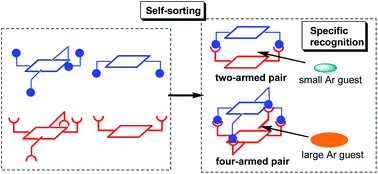Four- and two-armed hetero porphyrin dimers: their specific recognition and self-sorting behaviours†
Abstract
In this study we self-assembled the four-armed porphyrin hetero dimer capsule Cap4, stabilized through amidinium–carboxylate salt bridges, in CH2Cl2 and CHCl3. The dimer capsule Cap4 was kinetically and thermodynamically more stable than the corresponding two-armed dimer Cap2. The number of arms strongly influenced their recognition behaviour; guests possessing small aromatic faces (e.g., 1,3,5-trinitrobenzene) preferred residing in the cavity of the two-armed capsule Cap2, rather than in Cap4, both thermodynamically and kinetically; in contrast, large aromatic guests (e.g., 9,10-dibromoanthracene) were encapsulated predominantly by Cap4 because of favourable entropic effects. The number of arms enabled self-sorting behaviour of the dimer formation; complexation studies using an equimolar mixture of the four porphyrin constituents of the two capsules revealed the quantitative formation of the corresponding dimers Cap2 and Cap4. Furthermore, we examined the specific molecular recognition of Cap2 and Cap4; NMR experiments of mixtures of Cap2 and Cap4 in the presence of favourable guests for Cap2 and Cap4 revealed that these guest molecules were encapsulated selectively by their preferred hosts.

- This article is part of the themed collection: Supramolecular chemistry in OBC


 Please wait while we load your content...
Please wait while we load your content...